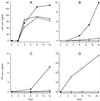Characteristics of a pathogenic molecular clone of an end-stage serum-derived variant of simian immunodeficiency virus (SIV(F359))
- PMID: 11533196
- PMCID: PMC114501
- DOI: 10.1128/JVI.75.19.9328-9338.2001
Characteristics of a pathogenic molecular clone of an end-stage serum-derived variant of simian immunodeficiency virus (SIV(F359))
Abstract
End-stage simian immunodeficiency virus (SIV) isolates are suggested to be the most fit of the evolved virulent variants that precipitate the progression to AIDS. To determine if there were common characteristics of end-stage variants which emerge from accelerated cases of AIDS, a molecular clone was derived directly from serum following in vivo selection of a highly virulent SIV isolate obtained by serial end-stage passage in rhesus monkeys (Macaca mulatta). This dominant variant caused a marked cytopathic effect and replicated to very high levels in activated but not resting peripheral blood lymphocytes. Furthermore, although this clone infected but did not replicate to detectable levels in rhesus monocyte-derived macrophages, these cells were able to transmit infection to autologous T cells upon contact. Interestingly, although at low doses this end-stage variant did not use any of the known coreceptors except CCR5, it was able to infect and replicate in human peripheral blood mononuclear cells homozygous for the Delta 32 deletion of CCR5, suggesting the use of a novel coreceptor. It represents the first pathogenic molecular clone of SIV derived from viral RNA in serum and provides evidence that not only the genetic but also the biological characteristics acquired by highly fit late-stage disease variants may be distinct in different hosts.
Figures








Similar articles
-
Infectious molecular clones from a simian immunodeficiency virus-infected rapid-progressor (RP) macaque: evidence of differential selection of RP-specific envelope mutations in vitro and in vivo.J Virol. 2006 Feb;80(3):1463-75. doi: 10.1128/JVI.80.3.1463-1475.2006. J Virol. 2006. PMID: 16415023 Free PMC article.
-
CXCR6-Mediated Simian Immunodeficiency Virus SIVagmSab Entry into Sabaeus African Green Monkey Lymphocytes Implicates Widespread Use of Non-CCR5 Pathways in Natural Host Infections.J Virol. 2017 Jan 31;91(4):e01626-16. doi: 10.1128/JVI.01626-16. Print 2017 Feb 15. J Virol. 2017. PMID: 27903799 Free PMC article.
-
Evolution of a simian immunodeficiency virus pathogen.J Virol. 1998 Jan;72(1):405-14. doi: 10.1128/JVI.72.1.405-414.1998. J Virol. 1998. PMID: 9420239 Free PMC article.
-
Genetically divergent strains of simian immunodeficiency virus use CCR5 as a coreceptor for entry.J Virol. 1997 Apr;71(4):2705-14. doi: 10.1128/JVI.71.4.2705-2714.1997. J Virol. 1997. PMID: 9060623 Free PMC article.
-
SIVagm: genetic and biological features associated with replication.Front Biosci. 2003 Sep 1;8:d1170-85. doi: 10.2741/1130. Front Biosci. 2003. PMID: 12957815 Review.
Cited by
-
Direct inoculation of simian immunodeficiency virus from sooty mangabeys in black mangabeys (Lophocebus aterrimus): first evidence of AIDS in a heterologous African species and different pathologic outcomes of experimental infection.J Virol. 2004 Nov;78(21):11506-18. doi: 10.1128/JVI.78.21.11506-11518.2004. J Virol. 2004. PMID: 15479792 Free PMC article.
-
The macrophage response to HIV-1: Intracellular control of X4 virus replication accompanied by activation of chemokine and cytokine synthesis.J Neurovirol. 2002 Dec;8(6):599-610. doi: 10.1080/13550280290100923. J Neurovirol. 2002. PMID: 12476353 Review.
References
-
- Balzarini J, Naesens L, Slachmuylders J, Niphuis H, Rosenberg I, Holy A, Schellekens H, De-Clercq E. 9-(2-Phosphonylmethoxyethyl)adenine (PMEA) effectively inhibits retrovirus replication in vitro and simian immunodeficiency virus infection in rhesus monkeys. AIDS. 1991;5:21–28. - PubMed
-
- Barbareschi M, Girlando S, Mauri F M, Forti S, Eccher C, Mauri F A, Togni R, Dalla Palma P, Doglioni C. Quantitative growth fraction evaluation with MIB1 and Ki67 antibodies in breast carcinomas. Am J Clin Pathol. 1994;102:171–175. - PubMed
-
- Baskin G B, Martin L N, Murphey-Corb M, Hu F S, Kuebler D, Davison B. Distribution of SIV in lymph nodes of serially sacrificed rhesus monkeys. AIDS Res Hum Retroviruses. 1995;11:273–285. - PubMed
MeSH terms
LinkOut - more resources
Full Text Sources

